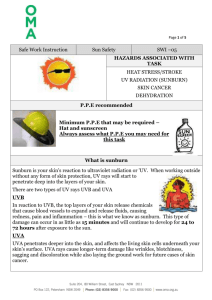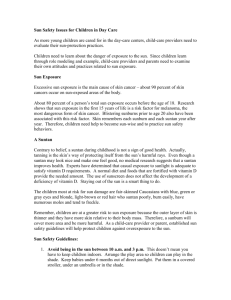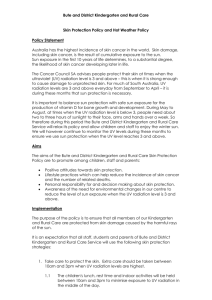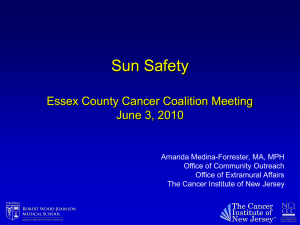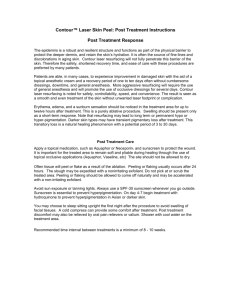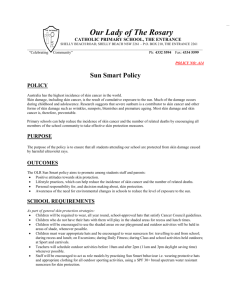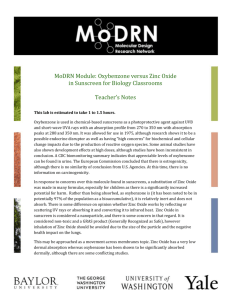Summer Sun Protection for Kids Brush up on sunscreen and sun
advertisement
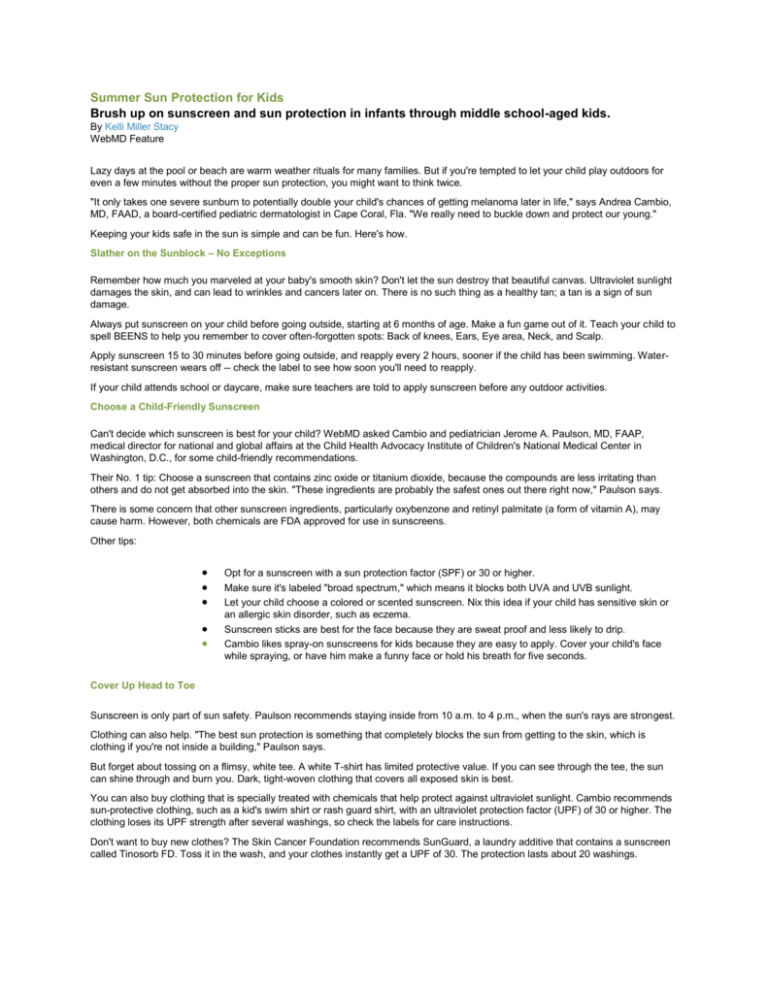
Summer Sun Protection for Kids Brush up on sunscreen and sun protection in infants through middle school-aged kids. By Kelli Miller Stacy WebMD Feature Lazy days at the pool or beach are warm weather rituals for many families. But if you're tempted to let your child play outdoors for even a few minutes without the proper sun protection, you might want to think twice. "It only takes one severe sunburn to potentially double your child's chances of getting melanoma later in life," says Andrea Cambio, MD, FAAD, a board-certified pediatric dermatologist in Cape Coral, Fla. "We really need to buckle down and protect our young." Keeping your kids safe in the sun is simple and can be fun. Here's how. Slather on the Sunblock – No Exceptions Remember how much you marveled at your baby's smooth skin? Don't let the sun destroy that beautiful canvas. Ultraviolet sunlight damages the skin, and can lead to wrinkles and cancers later on. There is no such thing as a healthy tan; a tan is a sign of sun damage. Always put sunscreen on your child before going outside, starting at 6 months of age. Make a fun game out of it. Teach your child to spell BEENS to help you remember to cover often-forgotten spots: Back of knees, Ears, Eye area, Neck, and Scalp. Apply sunscreen 15 to 30 minutes before going outside, and reapply every 2 hours, sooner if the child has been swimming. Waterresistant sunscreen wears off -- check the label to see how soon you'll need to reapply. If your child attends school or daycare, make sure teachers are told to apply sunscreen before any outdoor activities. Choose a Child-Friendly Sunscreen Can't decide which sunscreen is best for your child? WebMD asked Cambio and pediatrician Jerome A. Paulson, MD, FAAP, medical director for national and global affairs at the Child Health Advocacy Institute of Children's National Medical Center in Washington, D.C., for some child-friendly recommendations. Their No. 1 tip: Choose a sunscreen that contains zinc oxide or titanium dioxide, because the compounds are less irritating than others and do not get absorbed into the skin. "These ingredients are probably the safest ones out there right now," Paulson says. There is some concern that other sunscreen ingredients, particularly oxybenzone and retinyl palmitate (a form of vitamin A), may cause harm. However, both chemicals are FDA approved for use in sunscreens. Other tips: Opt for a sunscreen with a sun protection factor (SPF) or 30 or higher. Make sure it's labeled "broad spectrum," which means it blocks both UVA and UVB sunlight. Let your child choose a colored or scented sunscreen. Nix this idea if your child has sensitive skin or an allergic skin disorder, such as eczema. Sunscreen sticks are best for the face because they are sweat proof and less likely to drip. Cambio likes spray-on sunscreens for kids because they are easy to apply. Cover your child's face while spraying, or have him make a funny face or hold his breath for five seconds. Cover Up Head to Toe Sunscreen is only part of sun safety. Paulson recommends staying inside from 10 a.m. to 4 p.m., when the sun's rays are strongest. Clothing can also help. "The best sun protection is something that completely blocks the sun from getting to the skin, which is clothing if you're not inside a building," Paulson says. But forget about tossing on a flimsy, white tee. A white T-shirt has limited protective value. If you can see through the tee, the sun can shine through and burn you. Dark, tight-woven clothing that covers all exposed skin is best. You can also buy clothing that is specially treated with chemicals that help protect against ultraviolet sunlight. Cambio recommends sun-protective clothing, such as a kid's swim shirt or rash guard shirt, with an ultraviolet protection factor (UPF) of 30 or higher. The clothing loses its UPF strength after several washings, so check the labels for care instructions. Don't want to buy new clothes? The Skin Cancer Foundation recommends SunGuard, a laundry additive that contains a sunscreen called Tinosorb FD. Toss it in the wash, and your clothes instantly get a UPF of 30. The protection lasts about 20 washings. Wear a Hat Have your child take a tip from Barney and wear a silly hat outside. Take your child hat shopping, but be sure to purchase a hat with a wide brim that casts a shadow on the face. Too old for Barney? Look for a favorite sports team or school logo. Another outdoors must-have: Sunglasses. They are an important part of sun protection and recommended for kids of all ages. Make sure they filter both UVB and UVA rays. Two-year-old Anna Cheever never goes outside without her sunglasses and hat. She's worn a hat since birth, and nowadays will remind her mom if she forgets. "I want it to be second nature for her to put on a hat and sunscreen every time she goes outside," says Kara Cheever, a teacher in suburban Atlanta. "I hope that she continues to follow the good sun care habits that we practice together." Being a role model, is vital to helping your kids establish healthy sun habits. If they see you skipping the sunscreen, working on a tan, or forgoing a hat, chances are they will do so, too. Soothing a Sunburn If your child gets sunburn, and is active, playful, and does not have any blisters, here's how you can make him feel better. Place a cool compress to the sunburn. Apply aloe gel to the burned skin. Try placing the aloe in the fridge for a few minutes first before using. Give acetaminophen or ibuprofen. Check with your doctor for the correct dose. Give your child plenty of fluids. Do not use over-the-counter pain relieving products containing benzocaine on sun-burned skin. (These are called topical anesthetics.) They can often make the pain worse, and some people are allergic to the ingredient. If your child feels or looks ill, spikes a fever, or has blisters, seek medical attention.

